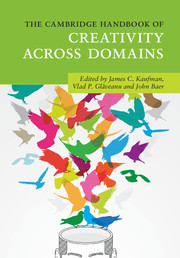Book contents
- The Cambridge Handbook of Creativity Across Domains
- The Cambridge Handbook of Creativity Across Domains
- Copyright page
- Dedication
- Contents
- Figures
- Tables
- Contributors
- Acknowledgments
- Part I Creativity and Domain
- Part II Creativity in the Traditional Arts
- Part III Creativity in the Sciences
- Part IV Creativity in Business
- Part V Newer Domains for Creativity Research
- 24 Intellectual Property
- 25 Gastronomy and Culinary Creativity
- 26 Tactical Creativity in Sport
- 27 Creativity in Non-Human Animals
- 28 Violent Innovation
- Part VI Creativity in Everyday Life
- Part VII Conclusion
- Index
- References
27 - Creativity in Non-Human Animals
from Part V - Newer Domains for Creativity Research
Published online by Cambridge University Press: 15 September 2017
- The Cambridge Handbook of Creativity Across Domains
- The Cambridge Handbook of Creativity Across Domains
- Copyright page
- Dedication
- Contents
- Figures
- Tables
- Contributors
- Acknowledgments
- Part I Creativity and Domain
- Part II Creativity in the Traditional Arts
- Part III Creativity in the Sciences
- Part IV Creativity in Business
- Part V Newer Domains for Creativity Research
- 24 Intellectual Property
- 25 Gastronomy and Culinary Creativity
- 26 Tactical Creativity in Sport
- 27 Creativity in Non-Human Animals
- 28 Violent Innovation
- Part VI Creativity in Everyday Life
- Part VII Conclusion
- Index
- References
Summary
While they are not traditionally associated with creativity, non-human animals often use creative behaviors, innovative tools, and social learning to increase evolutionary fitness. This creativity can result in better foraging, higher mating success, increased social standing, better problem-solving abilities, or any number of other adaptive traits. This chapter discusses some general subcategories of creativity and innovation in non-human animals, along with key studies in the area.
- Type
- Chapter
- Information
- The Cambridge Handbook of Creativity across Domains , pp. 492 - 506Publisher: Cambridge University PressPrint publication year: 2017



